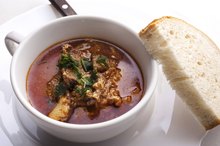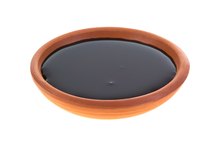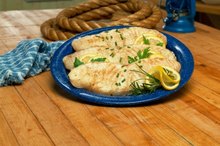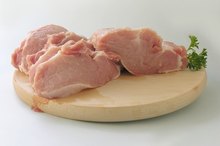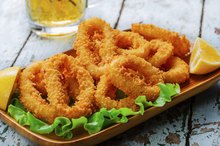Veal sausages are a flavorful alternative to pork sausages. Veal is often included in bratwurst, white boudin and bockwurst. It is usually the sole meat in weisswurst, or white sausage. Veal sausages also contain fat, seasonings and preservatives. Most have grain-based filler material in them as well, and sometimes the veal is blended with other meats, including pork, lamb, beef or poultry. While high in protein, veal sausage is also high in saturated fat and cholesterol. Eat it in moderation, and balance meals that include sausage with fresh fruit or vegetables, whole grains and low-fat dairy products.
Poaching
Fill a medium saucepan about 2/3 full with cold water.
Souvlaki Nutrition Information
Learn More
Salt the water lightly and bring it to a simmer over medium heat.
Add the veal sausages to the water and reduce the heat to medium-low.
How to Defrost Frozen Swordfish
Learn More
Poach the sausages in simmering water for about 30 minutes. Refrain from boiling sausages because high-heat methods can burst the casings.
Take the internal temperature of the sausages with a meat thermometer to make sure they've reached 165 degrees Fahrenheit.
- Fill a medium saucepan about 2/3 full with cold water.
- Add the veal sausages to the water and reduce the heat to medium-low.
Frying
Preheat 1 tbsp. of cooking oil in a large skillet over medium-high heat.
Turn the heat down to medium to avoid bursting the casings, and lay the veal sausages down in the pan.
Fry the sausages for half an hour, flipping them every five minutes or so with tongs.
Remove the sausages from the skillet once their internal temperature reaches 165 degrees Fahrenheit.
- of cooking oil in a large skillet over medium-high heat.
- Turn the heat down to medium to avoid bursting the casings, and lay the veal sausages down in the pan.
Grilling
Grease and preheat the grill to medium heat.
Poach the sausages for 10 minutes before grilling 1.
Set the heat to low and place the veal sausage links on the grill.
Close the lid and grill the sausages for about half an hour 1. Flip them every five minutes or so with tongs.
Take the sausages off the grill when their internal temperature reaches 165 degrees Fahrenheit.
Warnings
Never pierce the casings of veal sausages. Fat escapes through the holes, drying out the sausages and sapping them of flavor. When grilling, dripping fat can even be a fire hazard.
- Grease and preheat the grill to medium heat.
- Take the sausages off the grill when their internal temperature reaches 165 degrees Fahrenheit.
Related Articles
References
Writer Bio
Eric Mohrman has been a freelance writer since 2007, focusing on travel, food and lifestyle stories. His creative writing is also widely published. He lives in Orlando, Florida.



